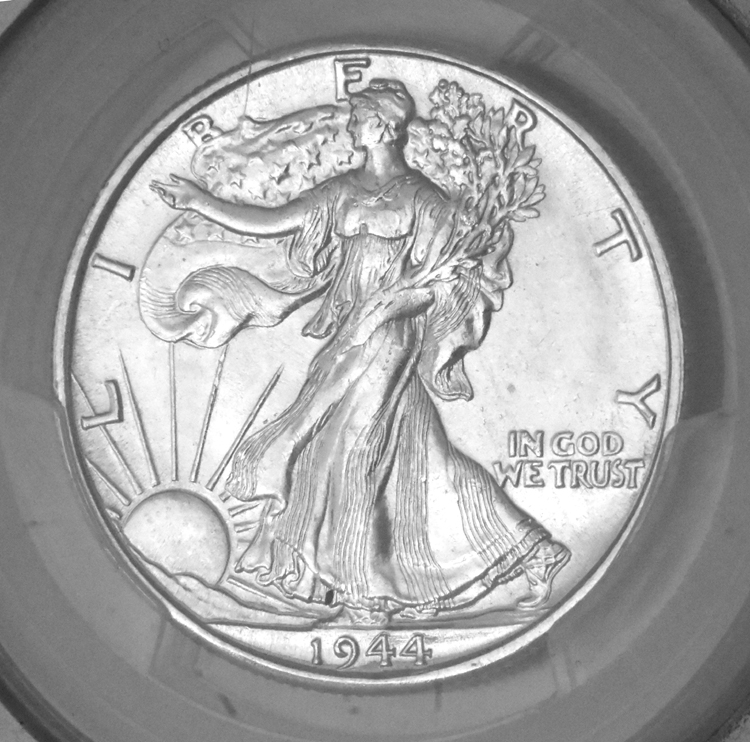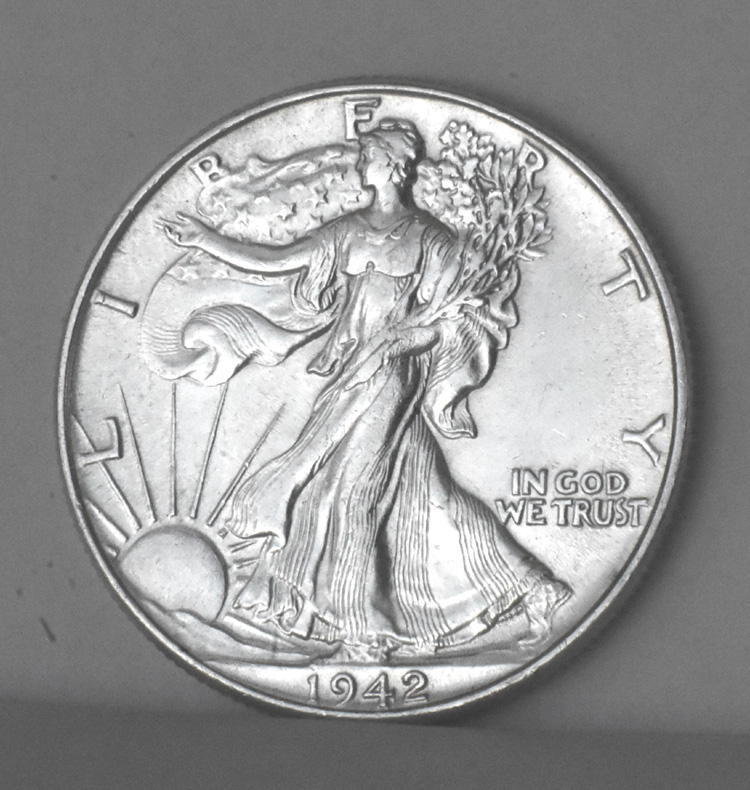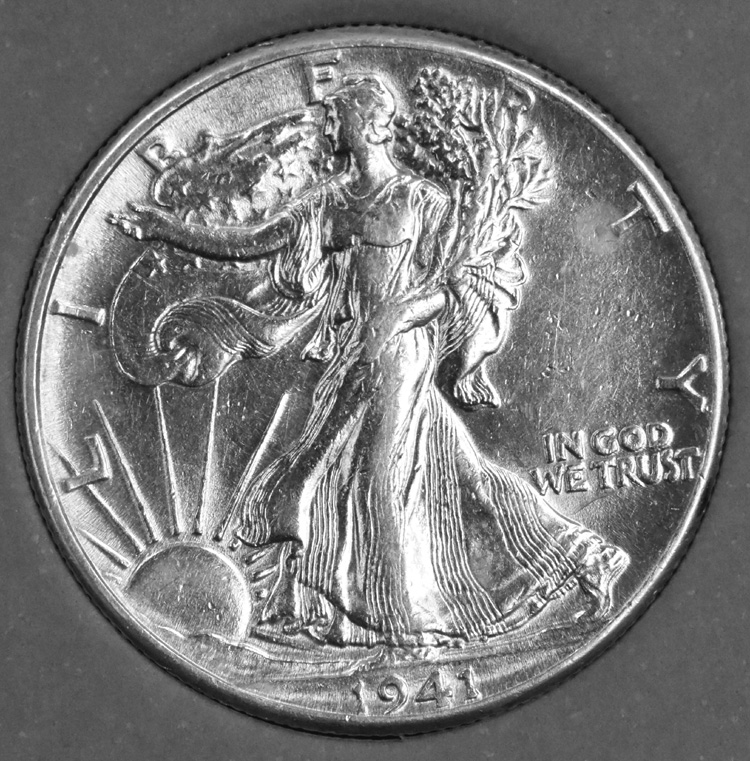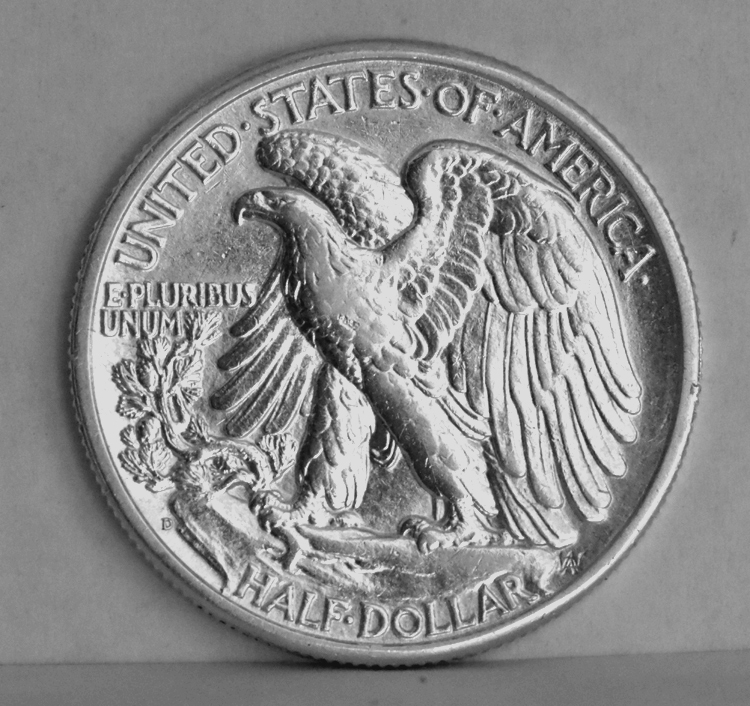Liberty Walking Half Dollar
1916 to 1947
 |
Designed by A. Weinman, this coin replaced the Barber half in 1916. His initials appear on the reverse if a coin has experienced little wear but soon disappeared in circulation. The eagle on the reverse was also completely redone, now facing to the left, with large wings behind. The coin was minted at Philadelphia, Denver, and San Francisco. Unfortunately, due to the raised figures on this coin, it suffered wear quickly and deeply while in circulation and thus a majority of uncirculated issues are relatively rare and expensive. The 1916 S, 1917 S, 1918 D, 1919 (P), 1919 S, 1920 D, 1920 S, and 1923 S all cost from $1000 to $4000 each. |
 |
| This is the highest grade Walking Liberty half that I own. It is an MS 65 slabbed coin I bought for Christine and gave to her. The coin cost $105. | This is the not exact reverse of the coin at left, but it is the same design. | |
 |
|
 |
| The coin above was sold as uncirculated and may actually be of that grade but I have not had it certified and so it cannot be claimed as such. It cost me $50 in April, 2020, and was bought to photograph for this page on the web site. | This is the reverse of the coin at left, which is stored in the misc halves and dollars Whitman album. | |
 |
|
 |
| My 1941 example above is almost uncirculated and cost me $14, being worth about $20 today. This coin above is in the Liberty Walking halves album which consists of two parts, one which gives examples of the 1916 to 1936 coins and the other gives examples of the 1937 to 1947. This latter album part contains 3 uncirculated coins and I also have an example of these coins in the U.S. Types album but that coin is an AU. | This is the reverse of the 1947 D issue which shows the initials of A. Weinman just below the wing tips to the right of the branch on which the eagle sits. This coin is supposed to be uncirculated but there is some obvious wear on the eagle's breast so I suspect that the seller overgraded the coin and it is actually an AU. |
1941: January 4: The short subject Elmer's Pet Rabbit is released, marking the second appearance of Bugs Bunny, and also the first to have his name on a title card. January 10: Lend-Lease is introduced into the U.S. Congress. January 27: U.S. Ambassador to Japan Joseph Grew passes on to Washington, D.C. a rumor overheard at a diplomatic reception about a planned surprise attack upon Pearl Harbor, Hawaii. February 8: The U.S. House of Representatives passes the Lend-Lease Act (260–165). April 10: The U.S. destroyer Niblack, while picking up survivors from a sunken Dutch freighter, drops depth charges on a German U-boat (the first "shot in anger" fired by America against Germany). May 6: At California's March Field, entertainer Bob Hope performs his first USO Show. May 21: 950 miles off the coast of Brazil, the freighter SS Robin Moor becomes the first United States (neutral) ship sunk by a German U-boat, after its crew have been allowed to disembark. July 26: In response to the Japanese occupation of French Indochina, U.S. President Franklin D. Roosevelt orders the seizure of all Japanese assets in the United States. August 6: Six-year-old Elaine Esposito undergoes an appendectomy and lapses into a coma that lasts for a record-breaking 37 years until her death in 1978. September 4: The USS Greer becomes the first United States Navy ship fired upon by a German submarine in the war, even though the United States is a neutral power. Tension heightens between the nations as a result. September: First production P38E Lightning fighter produced by Lockheed. October 17: The destroyer USS Kearny is torpedoed and damaged by German submarine U-568 off Iceland, killing 11 sailors (the first American military casualties of the war). October 31: The destroyer USS Reuben James is torpedoed and sunk by German submarine U-552 off Iceland, killing more than 100 U.S. Navy sailors. November 17: Attack on Pearl Harbor: Joseph Grew, the United States ambassador to Japan, cables to Washington, D.C., a warning that Japan may strike suddenly and unexpectedly at any time. November 26: U.S. President Franklin D. Roosevelt signs a bill establishing the 4th Thursday in November as Thanksgiving Day in the United States. December: Wonder Woman comic begins publication. December 6: Franklin D. Roosevelt makes a personal peace appeal to Emperor Hirohito of Japan. December 7: Attack on Pearl Harbor: The Imperial Japanese Navy Air Service stages a military strike on the United States Navy fleet at Pearl Harbor in the Territory of Hawaii, thus drawing the U.S. into World War II. December 8: Franklin Roosevelt gives his Infamy Speech. Within an hour the United States officially declares war on Japan. December 11: American forces repel a Japanese landing attempt at Wake Island. Germany and Italy declare war on the United States. The U.S. responds in kind. December 12: Hungary and Romania declare war on the United States. December 23: A second Japanese landing attempt on Wake Island is successful and the American garrison surrenders after a full night and morning of fighting. This calendar year is the wettest on record in Utah with 20.33 inches. In contrast to the wetness in the West, it is the driest calendar year in Tennessee with only 36.44 inches. 1942: January 13: Heinkel test pilot Helmut Schenk becomes the first person to escape from a stricken aircraft with an ejection seat. January 14: German submarine U-123 under the command of Reinhard Hardegen sinks a Norwegian tanker within sight of Long Island, before entering New York Harbor and sinking a British tanker off Sandy Hook the following night, as she leaves heading south along the coast. U-boat successes continue until around June 12. January 16: American film actress Carole Lombard and her mother are among all 22 killed aboard TWA Flight 3 when the Douglas DC-3 plane crashes into Potosi Mountain near Las Vegas while she is returning from a tour to promote the sale of war bonds. January 20: Nazis at the Wannsee Conference in Berlin decide that the "Final Solution (Endlösung) to the Jewish problem" is deportations to extermination camps. January 25: Thailand declares war on the United States and United Kingdom. February 8: Top United States military leaders hold their first formal meeting, to discuss American military strategy in the war. February 20: Lieutenant Edward O'Hare becomes America's first U.S. Navy flying ace of the war. February 23: WWII: Japanese submarine I-17 fires 17 high-explosive shells toward an oil refinery near Santa Barbara, California, causing little damage. February 25: "Battle of Los Angeles": Over 1,400 AA shells are fired at an unidentified, slow-moving object (probably a meteorological balloon) in the skies over Los Angeles. The appearance of the object triggers an immediate wartime blackout over most of Southern California, with thousands of air raid wardens being deployed throughout the city. At least 5 deaths are related to the incident. Despite the several-hour barrage no planes are downed. February 26: The worst coal dust explosion to date, in Honkeiko, China, claims 1,549 lives. March 11: Douglas MacArthur's escape from the Philippines – U.S. General Douglas MacArthur, his family and key members of his staff are evacuated by PT boat, under cover of evening darkness, from Corregidor in the Philippines. Command of U.S. forces in the Philippines passes to Major General Jonathan M. Wainwright. March 17: Operation Reinhard – The Nazi German Bełżec extermination camp opens in occupied Poland, about 1 km south of the railroad station at Bełżec in the Lublin district of the General Government. At least 434,508 people are killed here up to December 1942. March 18: Franklin D. Roosevelt, President of the United States, signs Executive Order 9102, creating the War Relocation Authority (WRA), which becomes responsible for the internment of Americans of Japanese and, to a lesser extent, German and Italian descent, many of them legal citizens. April: the Nazi German extermination camp Sobibór opens in occupied Poland, on the outskirts of the town of Sobibór. Between April 1942 and October 1943, at least 160,000 people are killed here. April 9: The Bataan Peninsula falls, and the Bataan Death March begins. April 10: Construction of the Nazi German extermination camp Treblinka II commences in occupied Poland near the village of Treblinka. Between July 23, 1942, and October 1943, around 850,000 people are killed here, more than 800,000 of whom are Jews. April 12: Disney's Bambi is released in theaters everywhere. April 14: German submarine U-85 is sunk by USS Roper off North Carolina. April 18: Doolittle Raid: A small force of B-25 Mitchell bomber aircraft, commanded by then-Lieutenant Colonel James "Jimmy" Doolittle bomb Tokyo, Japan. April 26: The Reichstag meets for the last time, dissolving itself and proclaiming Adolf Hitler the “Supreme Judge of the German People", granting him the power of life and death over every German citizen. May 8: The Battle of the Coral Sea (first battle in naval history where 2 enemy fleets fight without seeing each other's fleets) ends in an Allied victory. May 21: Mexico declares war against Nazi Germany, after the sinking of the Mexican tanker Faja de Oro by German submarine U-160 off Key West. June 5: The United States declares war on Bulgaria, Hungary and Romania. June 4–June 7: Battle of Midway: The Japanese naval advance in the Pacific is halted. June 7: Japanese forces invade the Aleutian Islands (the first invasion of American soil in 128 years). June 12: On her 13th birthday, Anne Frank makes the first entry in her new diary. June 23: The experimental early type nuclear reactor L-IV has an accident, becoming the first nuclear accident in history and consisting of a steam explosion and reactor fire in Leipzig. July 1–July 27: First Battle of El Alamein: British forces prevent a second advance by Axis forces into Egypt. July 6: Anne Frank's family goes into hiding in an attic above her father's office in an Amsterdam warehouse. July 18: The Germans test fly the Messerschmitt Me 262 (using only its jet engines) for the first time. July 23: The gas chambers at Treblinka extermination camp begin operation, killing 6,500 Jews newly arrived from the Warsaw Ghetto. August 7: Guadalcanal Campaign – The U.S. Navy and the U.S. Marine Corps begin the first American offensive of the war, with an amphibious landing on the island of Guadalcanal in the Solomon Islands. August 20: Plutonium is isolated for the first time, at the Metallurgical Laboratory of the University of Chicago. The 2-day Battle of the Eastern Solomons begins: Bombers from carrier USS Saratoga sink Japanese aircraft carrier Ryūjō near Santa Isabel Island, helping to lead to an Allied victory. August 27–28: Sarny Massacre: Nazi troops and the Ukrainian Auxiliary Police systematically execute more than 14,000 people, mostly Jews, in and around Sarny in German-occupied Poland. September 9: A Japanese floatplane drops incendiary devices at Mount Emily, near Brookings, Oregon, in the first of two "Lookout Air Raids", the first bombing of the continental United States. September 12: The RMS Laconia, carrying civilians, Allied soldiers and Italian prisoners of war, is torpedoed off the coast of West Africa and sinks, killing 1,649 people. October 2: Japanese troopship Lisbon Maru sinks, following a torpedo attack the previous day by submarine USS Grouper off the coast of China; 829 are killed, mostly British prisoners of war who (unknown to the attacker) were being held on board. October 3: The first A-4 rocket is successfully launched from Test Stand VII at Peenemünde, Germany. The rocket flies 147 kilometres wide and reaches a height of 84.5 kilometres, becoming the first man-made object to reach space. October 16: A cyclone and consequential floods in the Bay of Bengal kill 40,000 people, with particularly heavy damage around Contai. October 18: Hitler issues the Commando Order, which stipulates that all Allied commandos encountered by German forces should be executed immediately without trial, even in proper uniforms, in response to the Dieppe Raid and Operation Basalt conducted by the Allies. After the war, the Nuremberg trials finds this order a direct violation of the laws and customs of war. October 23: Award-winning composer and songwriter Ralph Rainger ("Thanks for the Memory") is among 12 people killed in a mid-air collision between an American Airlines DC-3 and a U.S. Army bomber near Palm Springs, California. October 28 Film actor Errol Flynn is accused of statutory rape by two teenage girls. October 30: British sailors board U-559 as it sinks in the Mediterranean and retrieve its Enigma machine and codebooks. November 13: British forces capture Tobruk. November 15: The Naval Battle of Guadalcanal ends: Although the United States Navy suffers heavy losses, it retains control of Guadalcanal. November 19: Battle of Stalingrad: Soviet Union forces under General Georgy Zhukov launch the Operation Uranus counter-attacks at Stalingrad, turning the tide of the battle in the USSR's favor. November 21: The completion of the Alaska Highway (also known as the Alcan Highway) is celebrated (however, the "highway" is not usable by general vehicles until 1943). November 26: The movie Casablanca premières at the Hollywood Theater in New York City. November 28: Cocoanut Grove fire: A fire in the Cocoanut Grove night club in Boston, Massachusetts, kills 491. December 1: Gasoline rationing begins in the United States. December 2: Manhattan Project: Below the bleachers of Stagg Field at the University of Chicago, a team led by Enrico Fermi initiates the first self-sustaining nuclear chain reaction. December 12: German troops began Operation Winter Storm, an attempt to relieve encircled Axis forces during the Battle of Stalingrad. December 28: North Atlantic Convoy ON 154 is heavily attacked by U-boats, sinking 13 ships. Date unknown: DDT is first used as a pesticide. 1944: January 15: 1944 San Juan earthquake: An earthquake hits San Juan, Argentina, killing an estimated 10,000 people, in the worst natural disaster in Argentina's history. January 20: The Royal Air Force drops 2,300 tons of bombs on Berlin. January 22: Operation Shingle: The Allies begin the assault on Anzio, Italy. January 25: A total solar eclipse is visible in Pacific Ocean, South America, Atlantic Ocean and Africa, the 48th solar eclipse of Solar Saros 130. January 27: The two-year Siege of Leningrad is lifted. January 31: Battle of Kwajalein: American forces land on Kwajalein Atoll and other islands, in the Japanese-held Marshall Islands. February 3: United States troops capture the Marshall Islands. February 8: 2,765 drown when USS Snook torpedoes Lima Maru. February 24: USS Rasher torpedoes Ryūsei Maru and Tango Maru; 7,998 drown. March 1: USS Trout torpedoes Sakito Maru; 2,495 drown. March 4: In Ossining, New York, Louis Buchalter, the leader of 1930s crime syndicate Murder, Inc., is executed at Sing Sing, along with Emanuel Weiss and Louis Capone. March 15: In Sweden, the 1864 law which had criminalized homosexuality is abolished. March 18: The last eruption of Mount Vesuvius in Italy kills 26, and causes thousands to flee their homes. March 20: British Royal Air Force Flight Sergeant Nicholas Alkemade's bomber is hit over Germany, and he has to bail out without a parachute from a height of over 13,123 ft. Tree branches interrupt his fall and he lands safely in deep snow. March 24: The "Great Escape": 76 Royal Air Force prisoners of war escape by tunnel "Harry" from Stalag Luft III this night. Only 3 men (2 Norwegians and a Dutchman) return to the UK; of those recaptured, 50 are summarily executed soon afterwards, in the Stalag Luft III murders. April 10: Rudolf Vrba and Alfréd Wetzler escape from Auschwitz concentration camp; on April 25–27 they prepare the Vrba–Wetzler report, one of the earliest and most detailed descriptions of the extermination of Jews in the camp. April 16: Allied forces start bombing Belgrade, killing about 1,100 people. This bombing fell on the Orthodox Christian Easter. April 26: USS Jack torpedoes Yoshida Maru No. 1; 2,649 drown. May 9: In the Ukrainian city of Sevastopol, Soviet troops completely drive out German forces, who had been ordered by Hitler to “fight to the last man. May 31: Destroyer escort USS England sinks the sixth Japanese submarine in two weeks. This anti-submarine warfare performance remains unmatched through the 20th-century. June 4: Rome falls to the Allies, the first Axis capital to fall. A hunter-killer group of the United States Navy captures the German submarine U-505, marking the first time a U.S. Navy vessel has captured an enemy vessel at sea since the War of 1812. Some significant intelligence data is acquired. June 5: The German navy’s Enigma messages are decoded almost in real time. June 6: D-Day: 155,000 Allied troops shipped from England land on the beaches of Normandy in northern France, beginning Operation Overlord and the Invasion of Normandy. The Allied soldiers quickly break through the Atlantic Wall and push inland, in the largest amphibious military operation in history. This operation helps liberate France from Germany, and also weakens the Nazi hold on Europe. June 13: Germany launches the first V-1 flying bomb attack on London. June 16: At age 14, George Stinney becomes the youngest person ever executed in the United States. June 20: A V-2 rocket becomes the first man-made object to cross the Kármán line and reach the edge of space. June 22: Operation Bagration: A general attack by Soviet forces clears the German forces from Belarus, resulting in the destruction of German Army Group Centre, possibly the greatest defeat of the Wehrmacht during WWII. June 29: USS Sturgeon torpedoes Toyama Maru; 5,400 drown. July 6: Hartford circus fire: More than 100 children die in one of the worst fire disasters in the history of the United States. At Camp Hood, Texas, future baseball star and 1st Lt. Jackie Robinson is arrested and later court-martialed, for refusing to move to the back of a segregated U.S. Army bus (he is eventually acquitted). July 17: Port Chicago disaster: The SS E. A. Bryan, loaded with ammunition, explodes at the Port Chicago, California, Naval Magazine, killing 320 sailors and civilian personnel. July 20: Adolf Hitler survives the 20 July plot to assassinate him led by Claus von Stauffenberg; he and his fellow conspirators in this and Operation Valkyrie are executed the following day. The annular solar eclipse of July 20, 1944 is visible in Africa, Indian Ocean, Asia, Pacific Ocean and Australia, and is the 35th solar eclipse of Solar Saros 135. July 21: Battle of Guam: American troops land on Guam (the battle ends August 10). July 26: A Messerschmitt Me 262 becomes the first jet fighter aircraft to have an operational victory. August 4: A tip from a Dutch informer leads the Gestapo to a sealed-off area in an Amsterdam warehouse, where they find Jewish diarist Anne Frank, her family, and others in hiding. All will die in the Holocaust, except for Otto Frank, Anne's father. August 5: The Warsaw Uprising: The Wola massacre begins. Between now and August 12, 40,000 to 50,000 Polish civilians will be indiscriminately massacred by occupying SS troops. August 18: Submarine USS Rasher sinks Teia Maru, Eishin Maru, Teiyu Maru, and aircraft carrier Taiyō from Japanese convoy HI71, in one of the most effective American "wolfpack" attacks of the war. August 19: More than 4,400 Japanese servicemen drown, when USS Spadefish torpedoes Tamatsu Maru. August 22: Tsushima Maru, an unmarked Japanese passenger/cargo ship, is sunk by torpedoes launched by the submarine USS Bowfin off Akuseki-jima, killing 1,484 civilians, including 767 schoolchildren. August 24: Liberation of Paris: The Allies enter Paris, successfully completing Operation Overlord. August 25: German surrender of Paris: General Dietrich von Choltitz surrenders Paris to the Allies, in defiance of Hitler's orders to destroy it. September 7: Shin'yō Maru incident: Japanese cargo ship SS Shinyō Maru is torpedoed and sunk in the Sulu Sea by American submarine USS Paddle while carrying 750 American prisoners of war; 688 perish. September 8: The first V-2 rocket attack on London takes place. September 14: The Great Atlantic hurricane makes landfall in the New York City area. September 18: HMS Tradewind torpedoes Jun'yō Maru; 5,620 drown. October 8: The Adventures of Ozzie and Harriet radio show debuts in the United States. October 9: Fourth Moscow Conference: British Prime Minister Winston Churchill and Soviet Premier Joseph Stalin begin a 9-day conference in Moscow, to discuss the future of Europe. October 10: 800 Romani children are systematically murdered at the Auschwitz concentration camp. October 13: The first V-2 rocket attack on Antwerp takes place. October 14: German Field Marshal Erwin Rommel commits forced suicide rather than face public disgrace and execution for allegedly conspiring against Adolf Hitler. October 21: Aachen, the first German city to fall, is captured by American troops. October 23–26: Naval Battle of Leyte Gulf in the Philippines – In the largest naval battle in history by most criteria and the last naval battle in history between battleships, combined United States and Australian naval forces decisively defeat the Imperial Japanese Navy. This is the first battle in which Japanese aircraft carry out organized kamikaze attacks. November 7: United States presidential election: Franklin D. Roosevelt wins reelection over Republican challenger Thomas E. Dewey, becoming the only U.S. president elected to a fourth term. November 10: Ammunition ship USS Mount Hood disintegrates from the accidental detonation of 3,800 tons of cargo, in the Seeadler Harbor fleet anchorage at Manus Island. 22 small boats are destroyed, 36 nearby ships damaged, 432 men are killed and 371 more are injured. November 22: Laurence Olivier's film Henry V, based on Shakespeare's play, opens in London. It is the most acclaimed and the most successful movie version of a Shakespeare play made up to that time, and the first in Technicolor. Olivier both stars and directs. November 27: RAF Fauld explosion: Between 3,450 and 3,930 tons of ordinance explodes at an underground storage depot in Staffordshire, England, leaving about 75 dead and a crater 1,300 yd across and 390 ft deep. The blast is one of the largest non-nuclear explosions in history, and the largest on UK soil. November 29: Submarine USS Archerfish sinks Japanese aircraft carrier Shinano. Shinano is the largest carrier built to this date, and will remain through the twentieth century the largest ship sunk by a submarine. December 14: The film National Velvet is released in the United States, bringing a young Elizabeth Taylor to stardom. December 15: A USAAF utility aircraft carrying bandleader Major Glenn Miller disappears in heavy fog over the English Channel, while flying to Paris. December 16: Germany begins the Ardennes offensive, later known as the Battle of the Bulge. December 17: Malmedy massacre: German SS troops under Joachim Peiper machine gun American prisoners of war captured during the Battle of the Bulge near Malmedy, and elsewhere in Belgium. General Dwight D. Eisenhower is promoted to the rank of 5-star U.S. Five-Star General. December 22: Brigadier General Anthony C. McAuliffe, commander of the U.S. forces defending Bastogne, refuses to accept demands for surrender by sending a one-word reply, "Nuts!", to the German command. December 24: Troopship SS Léopoldville is sunk in the English Channel by German submarine U-486. Approximately 763 soldiers of the U.S. 66th Infantry Division, bound for the Battle of the Bulge, drown. Fifty German V-1 flying bombs, air-launched from Heinkel He 111 bombers flying over the North Sea, target Manchester in England, killing 42 and injuring more than 100 in the Oldham area. The first complete U.S. production of Tchaikovsky's ballet The Nutcracker is presented in San Francisco, choreographed by Willam Christensen. December 26: American troops repulse German forces at Bastogne. |